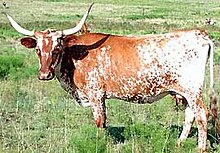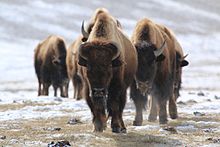Bovina (subtribe)
| Bovina Temporal range: Late Miocene - present, [1] | |
|---|---|
 | |
 | |
| Texas Longhorn Cattle (Bos taurus; top image) and a herd of American bison (Bison bison; bottom) | |
| Scientific classification | |
| Domain: | Eukaryota |
| Kingdom: | Animalia |
| Phylum: | Chordata |
| Class: | Mammalia |
| Order: | Artiodactyla |
| Family: | Bovidae |
| Subfamily: | Bovinae |
| Tribe: | Bovini |
| Subtribe: | Bovina Gray, 1821 |
| Type genus | |
| Bos | |
| Genera | |
| List
| |
| Synonyms | |
| |
Bovina is a subtribe of the Bovini tribe that generally includes the two living genera, Bison and Bos.[2] However, this dichotomy has been challenged recently by molecular work that suggests that Bison should be regarded as a subgenus of Bos.[3][4][5][6] Wild bovinans can be found naturally in North America and Eurasia (although domestic and feral populations have been introduced worldwide).[7]
Taxonomy[edit]
Placement within Bovini[edit]
| Phylogenetic relationships of extant genera of the tribe Bovini (Hassanin et al., 2013)[6] |
The majority of phylogenetic work based on ribosomal DNA, chromosomal analysis, autosomal introns and mitochondrial DNA has recovered three distinctive subtribes of Bovini: Pseudorygina (represent solely by the saola), Bubalina (buffalo), and Bovina.[8][9][5][6]
Genera and species[edit]
Extant[edit]
In 1945 American paleontologist and mammalogist George Gaylord Simpson had considered there to be three genera of bovinans.[10] In addition to recognizing Bos and Bison, he assigned the several Asiatic tropical species such as gaur and banteng into the genus Bibos.[10] The German zoologist Herwart Bohlken also agreed with these conclusions, though he believed that the two bison species should be lumped into Bison bison.[11] The kouprey was not included in Simpson's taxonomy,[10] while Bohlken (1958) considered the species to be a hybrid between banteng and cattle.[11]
Below is the Simpson (1945) taxonomy:[10]
- Subtribe Bovina (Gray, 1821)
- Genus Bibos (Hodgson, 1837)
- Genus Bison (Hamilton-Smith, 1827)
- Bison bonasus (Linnaeus, 1758) – European bison
- Bison bison (Linnaeus, 1758) – American bison
- Genus Bos (Linnaeus, 1758)
Subsequent taxonomic studies resulted Bibos to be reduced to as either a subgenus[12] or a junior synonym of Bos.[2] As shown below:
- Subtribe Bovina (Gray, 1821)
- Genus Bison (Hamilton-Smith, 1827)
- Bison bonasus (Linnaeus, 1758) – European bison
- Bison bison (Linnaeus, 1758) – American bison
- Genus Bos (Linnaeus, 1758)
- Genus Bison (Hamilton-Smith, 1827)
However recent molecular work on mitochondrial DNA and the Y-chromosome has completely revamped the evolutionary relationships among bovinans. These studies support of not only the inclusion of bison species into the genus Bos, but offer two radically different positions for the European bison. According to the mitochondrial DNA, these studies support the American bison being closely related to the yak, while the European bison is more related to the aurochs.[13][5] However a 2008 phylogenetic study using the Y-chromosome found the two bison species to form a clade. It also found that the yaks are an outgroup in relation to the rest of the bovinans, supporting their classification in the genus Poephagus.[14] Another study by Hassanin et al. (2013) using autosomal introns found support in the bison-yak clade.[6] This suggests the mitochondrial genomes is result of incomplete lineage sorting during divergence of Bos and Bison from their common ancestors rather than further post-speciation gene flow (ancient hybridization between Bos and Bison). There is evidence of limited gene flow from Bos primigenius taurus could account for the affiliation between wisent and cattle nuclear genomes (in contrast to mitochondrial ones).[15] These phylogenetic studies lead Groves and Grubb (2011), who conducted large scale taxonomic analysis on the world's ungulate species, to recommend classifying the two bison species as members of the genus Bos.[4]
Below is the listing of species recognized by Groves and Grubb (2011)[4] with species names following Castelló (2016) from Bovids of the World:[7]
- Subtribe Bovina (Gray, 1821)
- Genus Bos (Linnaeus, 1758)
- Bos javanicus (d’Alton, 1823) – Banteng
- Bos sauveli (Urbain, 1937) – Kouprey
- Bos gaurus (Hamilton-Smith, 1827) – Gaur
- Bos frontalis (Lambert, 1804) – Gayal
- Bos mutus (Przewalski, 1883) – Wild yak
- Bos grunniens (Linnaeus, 1766) – Yak
- Bos bison (Linnaeus, 1758) – American bison
- Bos bonasus (Linnaeus, 1758) – European bison
- †Bos caucasicus (Satunin, 1904) – Caucasian bison
- †Bos primigenius (Bojanus, 1827) – Aurochs
- Bos indicus (Linnaeus, 1758) – Zebu
- Bos taurus (Linnaeus, 1758) – Cattle
- Genus Bos (Linnaeus, 1758)
Fossil[edit]


The bovinans have a rich fossil record.[12] According to the fossil record and molecular studies, Bubalina and Bovina diverged from one and another from a common ancestor around 13.7 million years ago in the Late Miocene.[1][6][12] After arriving into Africa there was a rapid radiation of bovinan species in Africa in the Middle Pliocene. Among the diverse genera of African bovinans were two significant genera: Pelorovis and Leptobos. According to anatomical and morphological study on the various species of Pelorovis and Leptobos, it is believed the former genus evolved into Bos while the latter genus evolved into Bison during the Late Pliocene of East Africa.[16][17] Both lineages then left Africa and into Eurasia at the end of the Pliocene. While Bos inhabited much of Eurasia, some species of Bison had colonized North America by crossing over the Bering Land Bridge in two waves, the first being 135,000 to 195,000 years ago and the second being 21,000 to 45,000 years ago.[18][19][12] The exact relationships between fossil and extant bovinans problematic.[20]
Below is the list of fossil species that have been described so far (listed alphabetically):[12]
- Subtribe Bovina (Gray, 1821)
- Genus †Adjiderebos (Dubrovo & Burchak-Abramovich, 1984)
- †Adjiderebos cantabilis (Dubrovo & Burchak-Abramovich, 1984)
- Genus Bison (Hamilton-Smith, 1827)
- †Bison antiquus (Leidy, 1852)
- †Bison georgicus (Burchak-Abramovich & Vekua, 1994)
- †Bison hanaizumiensis (Matsumoto & Mori, 1956)
- †Bison latifrons (Harlan, 1825)
- †Bison menneri (Sher, 1997)
- †Bison palaeosinensis (Teilhard & Piveteau, 1930)
- †Bison priscus (Bojanus, 1827)
- †Bison schoetensacki (Freudenberg, 1914)
- †Bison sivalensis (Falconer, 1878)
- †Bison tamanensis (Vereshchagin, 1959)
- †Bison voigtstedtensis (Fischer, 1965)
- Genus Bos (Linnaeus, 1758)
- Subgenus Bos (Linnaeus, 1758)
- †Bos acutifrons (Lydekker, 1877)
- †Bos buiaensis (Martínez-Navarro et al., 2009)
- †Bos caucasicus (Burchak-Abramovich & Vekua, 1980)
- †Bos planifrons (Lydekker, 1877)
- Subgenus Bibos
- †Bos palaesondaicus (Dubois, 1908)
- Subgenus Poephagus (Gray, 1843)
- †Bos baikalensis (Verestchagin, 1954)
- Subgenus Bos (Linnaeus, 1758)
- Genus †Epileptobos (Hooijer, 1956)
- †Epileptobos groeneveldtii (Dubois, 1908)
- Genus †Ioribos (Vekua, 1972)
- †Ioribos aceros (Vekua, 1972)
- Genus †Leptobos (Rütimeyer, 1877)
- Subgenus †Leptobos (Rütimeyer, 1877)
- †Leptobos elatus (Croizet & Pomel, 1853)
- †Leptobos falconeri (Rütimeyer, 1877)
- †Leptobos furtivus (Duvernois & Guérin, 1989)
- Subgenus †Smertiobos (Duvernois, 1992)
- †Leptobos bravardi (Duvernois, 1989)
- †Leptobos brevicornis (Hu & Qi, 1975)
- †Leptobos crassus (Jia & Wang, 1978)
- †Leptobos etruscus (Falconer, 1859)
- Subgenus †Leptobos (Rütimeyer, 1877)
- Genus †Pelorovis (Reck, 1928)
- †Pelorovis howelli (Hadjouis & Sahnouni, 2006)
- †Pelorovis kaisensis (Geraads & Thomas, 1994)
- †Pelorovis oldowayensis (Reck, 1928)
- †Pelorovis praeafricanus (Arambourg, 1979)
- †Pelorovis turkanensis (Harris, 1991)
- Genus †Platycerabos (Barbour & Schultz, 1942)
- †Platycerabos dodsoni (Barbour & Schultz, 1941)
- Genus †Protobison (Burchak-Abramovich, Gadzhiev & Vekua, 1980)
- †Protobison kushkunensis (Burchak-Abramovich, Gadzhiev & Vekua, 1980)
- Genus †Urmiabos (Burchak-Abramovich, 1950)
- †Urmiabos azerbaidzanicus (Burchak-Abramovich, 1950)
- Genus †Yakopsis (Kretzoi, 1954)
- †Yakopsis stenometopon (Rütimeyer, 1865)
- Genus †Adjiderebos (Dubrovo & Burchak-Abramovich, 1984)
References[edit]
- ^ a b Hassanin, A.; Ropiquet, A. (2004). "Molecular phylogeny of the tribe Bovini (Bovidae, Bovinae) and the taxonomic status of the Kouprey, Bos sauveli Urbain 1937". Molecular Phylogenetics and Evolution. 33 (3): 896–907. doi:10.1016/j.ympev.2004.08.009. PMID 15522811.
- ^ a b Wilson, W.E.; Reeder, D.M., eds. (2005). Mammal Species of the World: A Taxonomic and Geographic Reference. The Johns Hopkins University Press.
- ^ Lenstra, J.A.; Bradley, D.G. (1999). "Systematics and phylogeny of cattle". The Genetics of Cattle. CAB International. pp. 1–14.
- ^ a b c Groves, C.; Grubb, P. (2011). Ungulate Taxonomy. The Johns Hopkins University Press.
- ^ a b c Bibi, F. (2013). "Phylogenetic relationships in the subfamily Bovinae (Mammalia: Artiodactyla) based on ribosomal DNA". BMC Evolutionary Biology. 13 (166): 166. doi:10.1186/1471-2148-13-166. PMC 3751017. PMID 23927069.
- ^ a b c d e Hassanin, A.; An, J.; Ropiquet, A.; Nguyen, T.T.; Couloux, A. (2013). "Combining multiple autosomal introns for studying shallow phylogeny and taxonomy of Laurasiatherian mammals: Application to the tribe Bovini (Cetartiodactyla, Bovidae)". Molecular Phylogenetics and Evolution. 63 (3): 766–775. doi:10.1016/j.ympev.2012.11.003. PMID 23159894.
- ^ a b Castelló, J.R. (2016). Bovids of the Word. Princeton University Press.
- ^ Tanaka, K.; Solis, C.D.; Masangkay, J.S.; Maeda, K.L.; Kawamoto, Y.; Namikawa, T. (1996). "Phylogenetic relationship among all living species of the genus Bubalus based on DNA sequences of the cytochrome b gene". Biochemical Genetics. 34 (11): 443–452. doi:10.1007/BF00570125. PMID 9126673. S2CID 22075565.
- ^ Hassanin, A.; Douzery, E. J. P. (1999). "Evolutionary affinities of the enigmatic saola (Pseudoryx nghetinhensis) in the context of the molecular phylogeny of Bovidae". Proceedings of the Royal Society B: Biological Sciences. 266 (1422): 893–900. doi:10.1098/rspb.1999.0720. PMC 1689916. PMID 10380679.
- ^ a b c d Simpson, G.G. (1945). "The principles of classification and a classification of mammals". Bulletin of the AMNH. 85: 1–350. hdl:2246/1104.
- ^ a b Bohlken, H. (1958). "Vergleichende Untersuchungen an Wildrindern (Tribus Bovini Simpson 1945)". Zoologische Jahrbücher. 68: 113–220.
- ^ a b c d e Hassanin, A. (2014). "Systematic and evolution of Bovini". In Melletti, D.R.; Burton, J. (eds.). Ecology, Evolution and Behaviour of Wild Cattle: Implications for Conservation. Cambridge University Press. pp. 7–20.
- ^ Guo, S.; Liu, J.; Qi, D.; Yang, J.; Zhao, X. (2006). "Taxonomic placement and origin of yaks: implications from analyses of mtDNA D-loop fragment sequences". Acta Theriologica Sinica. 26 (4): 325–330. Archived from the original on 2012-03-08.
- ^ Nijman, I.J.; Van Boxtel, D. C.; Van Cann, L. M.; Marnoch, Y.; Cuppen, E.; Lenstra, J. A (2008). "Phylogeny of Y chromosomes from bovine species" (PDF). Cladistics. 24 (5): 723–726. doi:10.1111/j.1096-0031.2008.00201.x. S2CID 86619378. Archived from the original (PDF) on 2017-08-09. Retrieved 2017-11-05.
- ^ Massilani, Diyendo; Guimaraes, Silvia; Brugal, Jean-Philip; Bennett, E. Andrew; Tokarska, Malgorzata; Arbogast, Rose-Marie; Baryshnikov, Gennady; Boeskorov, Gennady; Castel, Jean-Christophe; Davydov, Sergey; Madelaine, Stéphane; Putelat, Olivier; Spasskaya, Natalia N.; Uerpmann, Hans-Peter; Grange, Thierry; Geigl, Eva-Maria (21 October 2016). "Past climate changes, population dynamics and the origin of Bison in Europe". BMC Biology. 14 (93): 93. doi:10.1186/s12915-016-0317-7. PMC 5075162. PMID 27769298.
- ^ Martínez-Navarro, Bienvenido; Antonio Pérez-Claros, Juan; Palombo, Maria Rita; Rook, Lorenzo; Palmqvist, Paul (2017). "The Olduvai buffalo Pelorovis and the origin of Bos". Quaternary Research. 68 (2): 220–226. doi:10.1016/j.yqres.2007.06.002. S2CID 55104027.
- ^ Haile-Selassie, Yohannes; Vrba, Elizabeth S.; Bibi, Faysal (2009). "Bovidae". In Haile-Selassie, Yohannes; WoldeGabriel, Giday (eds.). Ardipithecus Kadabba: Late Miocene Evidence from the Middle Awash, Ethiopia. University of California Press. pp. 295–. ISBN 978-0-520-25440-4.
- ^ An Alaska volcano and DNA reveal the timing of bison's arrival in North America, Alaska Dispatch News, Yereth Rosen, March 27, 2017. Retrieved 28 March 2017.
- ^ Froese, Duane; Stiller, Mathias; Heintzman, Peter D.; Reyes, Alberto V.; Zazula, Grant D.; Soares, André E. R.; Meyer, Matthias; Hall, Elizabeth; Jensen, Britta J. L.; Arnold, Lee J.; MacPhee, Ross D. E.; Shapiro, Beth (2017). "Fossil and genomic evidence constrains the timing of bison arrival in North America". Proceedings of the National Academy of Sciences. 114 (13): 3457–3462. Bibcode:2017PNAS..114.3457F. doi:10.1073/pnas.1620754114. PMC 5380047. PMID 28289222.
- ^ Bibi, F. (2009). "The fossil record and evolution of Bovidae" (PDF). Palaeontologia Electronica. 12 (3): 1–11.


 French
French Deutsch
Deutsch